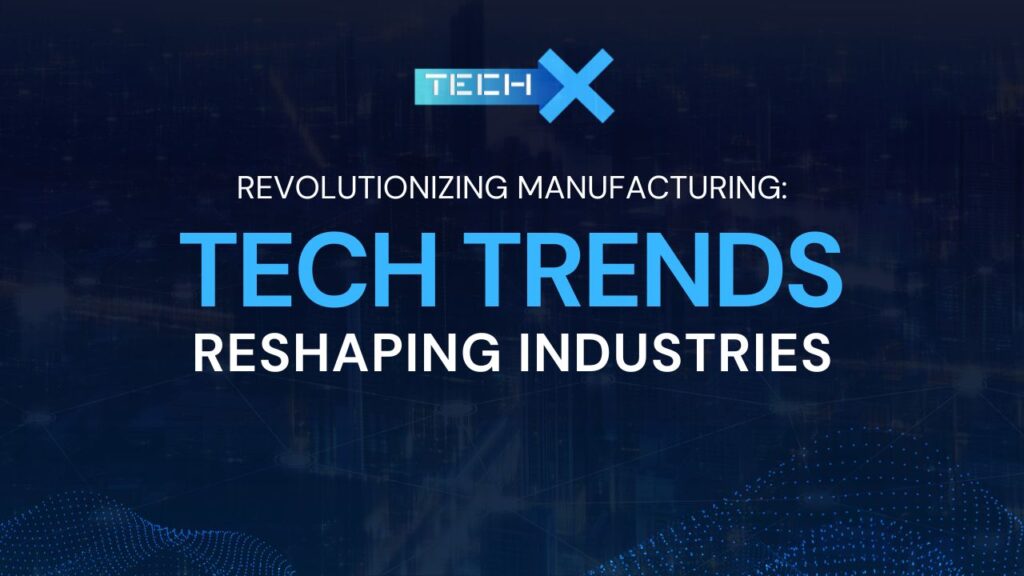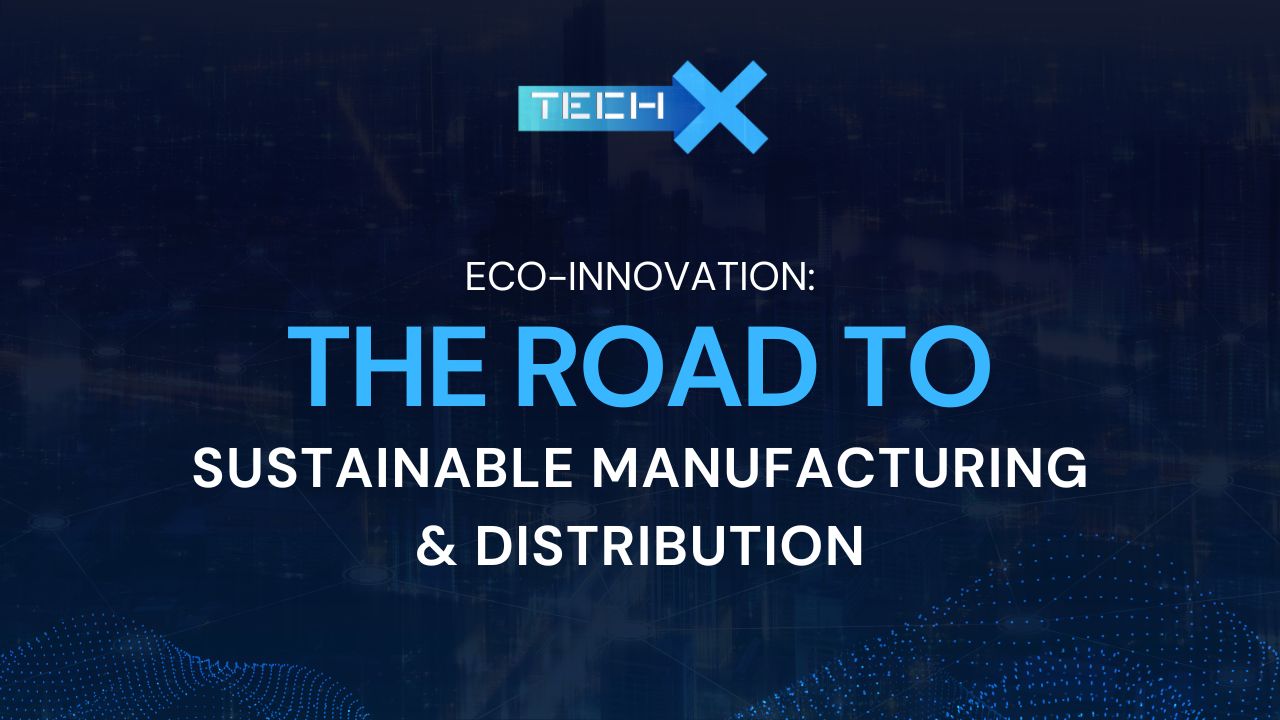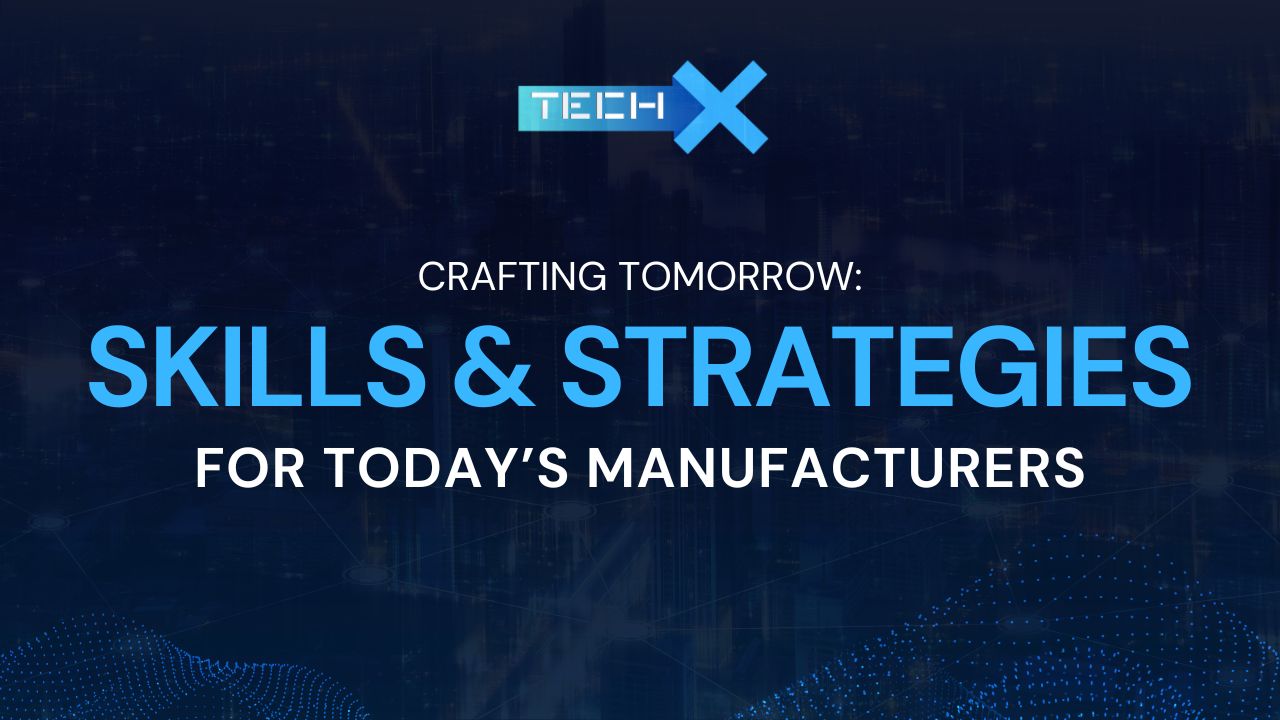Show Notes:
Join Merritt DeGraw and Seth Waters in the debut episode of the TechX Podcast, where they explore the evolving intersection of technology and business. Merritt, the Chief Technology Officer at Fortuna, shares insights into his journey through the tech landscape, discussing his experiences in networking, medical devices, education, and more. The conversation delves into the current landscape of manufacturing and distribution, uncovering trends, challenges, and the transformative power of technology, while emphasizing the role of automation, machine learning, and robotics in reshaping these industries. Tune in now to discover everything tech and business in this episode from the TechX Podcast!
Topics Discussed:
- Merritt DeGraw’s journey in technology
- The role of automation, machine learning, and robotics in manufacturing and distribution
- Trends and challenges in the manufacturing and distribution sector
- Data security and protecting against cyber threats.
- Practical steps for leaders in manufacturing and distribution to embrace technology
Quotes
You’ve got to be able to meet the demands of the organization. And so, that is a challenge, you know, how fast things are changing in this marketplace and how things are changing in the industry in general across all verticals. I think it’s like the wild, wild West. So people need to be able to keep up with that change.
Merritt DeGraw
One is understanding the flow of how you get things done. A lot of times I find that the issue is not, you know, kind of the systems that they have, but it’s the steps that they take. They may not understand their processes fully.
Merritt DeGraw
Everything should be built with security in mind
Merritt DeGraw
Education is a big part of that conversation to say, I want to make sure that these people understand when they get an email from somebody that’s outside that you don’t click on the envelope, you don’t click on the attachment.
Merritt DeGraw
…Educate yourself to get the others involved and start to really kind of together create that shared vision to drive those needles forward.
Merritt DeGraw
Transcript:
Seth Waters: Well, welcome to the Tex X podcast, where the future of technology intersects with business and excited be with you today. I’m Seth Waters. I’m the chief marketing officer at Fortuna and I’m here with Merritt DeGraw, the brains behind our show. Merritt, good to be with you today.
Merritt DeGraw: Pleasure to be here. Thank you.
Seth Waters: Before we jump into this new podcast, it’s really a new conversation. Before we jump right in, I’d love for you to take a few minutes and talk about your past. You’ve been in technology for many years. You’re now the chief technology officer at Fortuna, but I’d like to just have you share about some of the story. What’s your story?
Seth Waters: How have you gotten to where you are today?
Merritt DeGraw: It’s been a journey. I started off in networking back in the day, back when I was at Akamai Technology Session interview before Akamai and then, you know, dot com bust happened, moved in to medical device, worked at a company called NuVasive. They created the tools for minimal access, spinal surgeries. And I was the head guy there from I reporting directly to CFO and again helped them kind of build innovative technologies for helping people, you know, improve their outcomes from surgeries, from their spinal surgery.
Seth Waters: Wow.
Merritt DeGraw: Very interesting. And then kind of moved into larger companies work and education company. So that’s where I met Jack, oddly enough. And so we you know we were online education for profit education company building building a kind of a tracking solution for our students and such and giving them, you know, next generation education right again and then moved into a little bit of defense slash transportation areas when I was working at Cubic Technologies, doing a move to the cloud. Basically that’s kind of the main reason I was hired there. And I started helping out with some DevOps conversations also. And, and that led me into consulting career that eventually I landed here. So.
Seth Waters: Wow. So you’ve you’ve done a lot of things that have prepared you to be able to talk as an expert about a lot of different technologies.
Merritt DeGraw: Yes.
Seth Waters: Now, you mentioned Jack, and Jack is the CEO at Fortuna, the company where you are the chief technology officer right now amongst a whole bunch of other things. You know, as it is, we all have our hands on a lot of different projects, you know, as you do. But what is your job and what is your role right now as the chief technology officer at Fortuna?
Seth Waters: What does that encompass? What does that include for you?
Merritt DeGraw: Well, you know, again, I you know, here I think it branches outside of the technology. The the information technology space. Right. And we go into more, you know, dealing with things like hydrogen generation, green energy production, I guess it’s I should say, is probably a better way to say it. But also, you know, moving into, you know, innovative technologies like blockchain and Bitcoin rights, we do it. We have a I’m also a CTO at plant capacity, which is a Bitcoin mining company, I should say a demand response company, because not only it’s not just Bitcoin mining, but it’s being able to help manage the balance of the grid, right? Again, we’re not actually producing power in this case, but for the most part we’re able to help them kind of plan accordingly. Think of like an online battery that we’re able to shut down when they need the power. And then we we continue back on when we what we’re doing when we’re up and functioning against.
Seth Waters: Wow. So you’ve got your hands in a lot of projects right now. A lot of moving pieces.
Merritt DeGraw: Yes. Iot stuff with, you know, manufacturing stuff, you know, again, distribution area stuff. I mean, we’re having conversations all over the place where we may be manufacturing ourselves here pretty soon. So there’s a lot of a lot of moving parts at the moment.
Seth Waters: Yeah. And we’re going to jump into all of that because there’s so much to talk about right now, especially the manufacturing and distribution space. So we’re going to jump into technology and that in just just a minute. But I’m really excited for this podcast. I’m really excited about the tech podcast because you know, over the next 12 months we are going to be filming several series of these conversations talking about how technology is intersecting different areas of business. We’re going to be talking about new space, we’re going to be talking about health care. We’re going to be jumping in today into manufacturing and distributing. We’re also going to be talking about energy in a few months. And I’m very excited about that. So if you’re tuning in for the first time today, don’t don’t disappear. Make sure you come back. There’s can be a lot of valuable information and really touching on how technology intersects with all of those areas and the emerging technology that’s that’s coming and excited to get to glean from you a lot of understanding and information as we’re moving forward. As an expert in this area today, We’re going to start off by talking about manufacturing and distribution and where technology meets those. Now, as we jump into it, you know, we’ve had many conversations over the last few months. This is an area of technology that seems to lag a little bit behind. Would you say that? Is that a fair assessment?
Merritt DeGraw: I mean, yes, I would say it’s a fair assessment. I think, you know, many industries have the same challenges, but I think manufacturing distribution in particular, I think some groups and some companies are ahead of the game where other groups are behind the game, primarily just because, you know, we’ll talk about a little bit deeper later on. But but there’s definitely challenges in some in many organizations that we go into and we talk with. So, yeah.
Seth Waters: Well, let’s talk about some of the current trends and challenges in manufacturing and distribution today. What would you say are some of the current trends that you are seeing in manufacturing and distribution today?
Merritt DeGraw: So a lot of automation, right? I think there’s a lot of people, I should say there’s the vision of automation. I think there’s some people, some people know how to do it. I think, you know, if you look at the Amazons of the world, they have they’ve they’ve they’ve got that number right. I think from an automation perspective. But then you’re getting some of the laggards are kind of, I would say laggards like is probably not the right way, but I would say some of the people that are a little behind the curve are, you know, again, I think they’re having people challenges, they’re having technology challenges. Again, they’re dealing with some legacy systems, some technical debt, if you want to call it. Yeah, that is causing a little bit of consternation.
Seth Waters: Yeah. What are some of the biggest challenges that companies in this space are dealing with? You mentioned, you know, older systems and different things. What are some of the biggest challenges?
Merritt DeGraw: Well, I think people as a people process technology, right? I think those are the key areas. And I think many organizations that we’ve been in, they you know, they’ve got people challenges, I should say, you know, getting the knowledge of kind of automation and the knowledge around tying systems together to make it more kind of user friendly, more easy to do business with. Right. Those are areas where I find a lot of people have challenges. Many of the organs that we go to have challenges in that area, not all, but some. And again, I think that is where, you know, again, the people I always focus on the people process technology areas because again, the technology itself is is not as is it’ll be solved if you solve the people and process technology, the people and process side of the puzzle.
Seth Waters: So that’s really interesting. You know, how is technology reshaping the manufacturing and distribution sector?
Merritt DeGraw: Well, you know, I think if you look what is happening today, there’s a heavy focus on machine learning. And I think those are the areas that are people that are kind of driving it. There’s a lot of interest, I should say, in that industry in those areas right now in manufacturing and automation around, you know, robots and cobots and those type of things to where you’re you’re because people again, we go back to the people conversation. Either people don’t have the skills or it’s hard to find the people that have the skills. So what they’ve got to do is automate, right? So there’s that risk or that challenge that they have to overcome to get to a spot where they could actually meet demand. Right? Because it’s all ultimately and this is where I think the business comes into it is you’ve got to be able to meet the demands of the organization. Yeah. And so and so that’s that is a challenge. Again, if you look at how fast things are changing in this marketplace and how things are changing in the industry in general across all verticals, I think it’s like the wild, wild West. So people need to be able to keep up with that change.
Seth Waters: Well, we’re going to talk about that in the next episode. Part two of this podcast. Upskilling our employees, right? Really getting people trained for the emerging tech. But before we jump into that, you know, what are some of the key technologies you mentioned automation and what are some of the other key technologies that are driving change in manufacturing and distribution?
Merritt DeGraw: Well, again, automation is pretty broad, right? There’s software automation connecting to be able to automate connections to your vendors, to your suppliers, to your customers. Ultimately, I think it’s a customer conversation, right In my mind, if you look at the way like the Teslas of the world, that, you know, that direct to consumer is actually starting to pick up in a lot of areas. So the whole, you know, kind of distributor kind of model is, yeah, I’m not saying it’s going away, but it’s changing. Right. And I think that’s part of what’s driving the conversations around automation and kind of be able to drive the drive to speed to market basically is what it is right now. Again, whether you’re talking distribution, which is a whole nother conversation that it is on, I don’t see again, I think that not going away, but again, causing challenges. Again, Amazon, if you look at the way Amazon does their market, right, they’re one stop shop. There’s no more you know distributor distributor that distributor right. You know as you deal with the old kind of the old school but let’s call it the the older way of doing things right.
Seth Waters: Yeah. Talk to me more about that would you that drive to get to market, that drive to go to market, that speed that need? How are companies processing that right now and what are some ideas that you think could be helpful in that process?
Merritt DeGraw: One is understanding the flow of how you get things done. A lot of times I find that the issue is not, you know, kind of the systems that they have, but it’s the steps that they take. They may not understand their processes fully. I find that a lot of times because a lot of these people didn’t build it per se. Some did, some didn’t. Right. But they don’t quite fully understand the flow and where they have those hindrances. Right. In those challenges or those speed bumps, if you want to call them that, to get the market faster. So really understanding how you how you one, develop the product, how you get it to market or how you prep it for market and then productize it if you want to call it that way. And then then how you what’s the methodology to, to get it out in your customers hands.
Seth Waters: That’s beautiful. And I, you know, one question that comes to mind is how do you ensure data security and protect against cyber threats in a digitally driven industry?
Merritt DeGraw: That’s again, it’s getting harder and harder nowadays, especially, you know, I mean, you look at all the breaches, you look at the ransomware that’s out there today, a lot of, you know, kind of what you have to build is that defense in depth. I think, you know, this is a tried and true methodology that they talk about defense in depth. And it’s you know, it’s been out there for a bit, but really understanding kind of one, everything should be built with security in mind, Right. Versus trying to, you know, hey, I’m going to put whatever in place to make sure we’re able to go from A to Z. Right. I think a lot of it is making sure that, you know, intent is given to security in everything that you do as part of your building process, whether it be software development or whether it be software that’s on a machine like, let’s say a car, for instance, a Tesla. You know, if you look at you know, think about the danger associated with, you know, if somebody has a breach on a car and somebody is able to control your car, it’s a it’s you’re talking life and death now. Right. So ultimately, you know, being able to be able to to build those mechanisms, like whether you’re building software to be able to deploy the software in a secure manner, a lot of people are pushing down the DevOps conversation now. And to say a secure DevOps or devsecops, I think is what the term is now. But yeah, I think ultimately is build those mechanisms, build the controls in place and the governance over it to ensure, you know, your checks and balances are there to ensure that you’re you are secure as you move forward. Also, education is a big part of that conversation to say, I want to make sure that these people understand when they get an email from somebody that’s outside that you don’t click on the envelope, you don’t click on the attachment. Again, it’s not unexpected component, right? But ultimately, education is the key factor to try to, you know, again, you want to mitigate as much as you possibly can and limit the amount of blast radius if you want to call it there. But ultimately, you want to again, try to educate your people, get everybody on the same page, put the tools in place to be able to facilitate a capture if there is a breach, Right?
Seth Waters: So that’s so good. So to bring it home at the Tech X podcast, we like to bring it home. We like to bring it down to the road level. How do we get started with some traction in there? So for for folks in the marketing and or so for folks in the manufacturing and distribution industry, what are some good starting points? If you were to say, and I lead at one of these companies or perhaps you’re on the executive team and you’re looking at bringing in security into your your technology systems, where do you start?
Merritt DeGraw: Education, I think, is a big part of it, Right? Well, again, well, there’s two actuators, I think. Right. One, I think a lot of people a lot of it folks are not don’t understand how to quite pose the ask. Right. I think that’s one of the challenge that I had when I was when I was, you know, you know, one of the places that are at many of the places that it was understanding how to make the right business argument, to be able to help justify the expenditure, because these are not small expenditures many times. Right. Right. So you’re talking about transformational components, but ultimately is being able to understand is first start to look at what your business outcomes are and your objectives are. That’s how I always start as I look, Hey, where do you want to go when you grow up as a company? Right? From a business perspective, Then you start to say, okay, how are you going to get there? Right? So you basically start to build out that roadmap based off of where you want to be, because usually, you know, any any organization usually has some sort of strategic planning conversation to say, Hey, here are the elements that we need to attack this year to be successful, right? There’s also external elements that people are adding to that same strategy, their strapline, right? So ultimately you want to layer whatever department you’re in. I don’t care if you’re in I.T, whether you’re in operations, whether you’re in finance, legal, you name it. Ultimately, all everybody’s goals and objectives should lead into that, that conversation around where the strapline is and where we want to go. And then ultimately you’ve got to say, okay, if you want to be here, you say you want to you know, you want to compete with Amazon or you want to compete with whoever.
Ultimately, you need to be able to one, have the people that are able to do that work to get you to that spot to you have the processes in place to be able to make that happen. And then three, the technology that to get the other first parts in you layer in the technology is part of it, right? And again, you have to have the budget associated with it, right? You have to have the, the, the shared vision. If you want to call it, and make sure everybody’s rowing in the same direction. Because many times I’ve seen, you know, you know, siloed organizations kind of worked not on purpose, but worked against each other because again, with their lack of communication, the lack of transparency, whatever it is, but that’s where I find most of the challenges are. It’s not the the information implementation of technologies, but most of time it’s either budget or or inadvertent mishaps if you want to cause good.
Seth Waters: Well, merit. This has been a great conversation and I’m excited. I’m excited to dive into part two is we jump forward and and learn more as as folks are walking away from this first episode. What are some key next steps for leaders in the manufacturing and distribution space? Walking Waste from this first episode? What are some things they can do? Some key takeaways?
Merritt DeGraw: You know, I think one get better integrated with your business unit, with your I’ll take it from different perspectives. Right. From an AI perspective, understand kind of, you know, what your business is doing, how they’re doing it in branch and other areas. I think people have started to head this direction. You know, again, over the last you know, they talk about that business technology melding. Right. And you see a lot of CIOs that are driving that direction to where they’re not order takers, but they are helping to drive the business forward, especially as you’re starting to talk automation, you’re starting to talk, you know, robots and things in cobots and robots in the in the in your ecosystem. But I think a lot of it is, you know, one, educate yourself to get the others involved and start to really kind of together create that shared vision to drive those needles forward.






